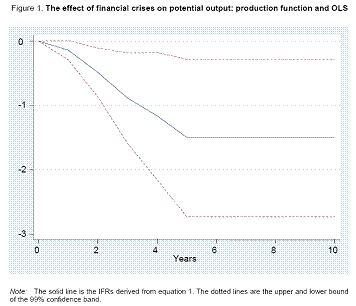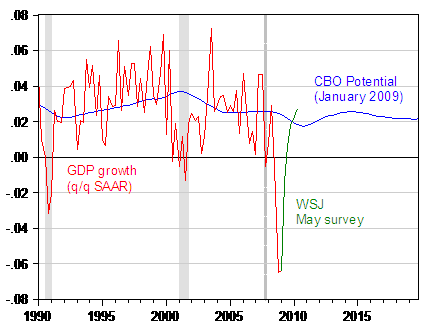In several past posts, I’ve been taken to task for using the CBO measure of the output gap (and the associated measure of potential GDP) [0] [1]. Some criticize the false sense of certainty that is provided by the official measures, since they are known to be revised as data comes in. Some criticize the measures on the basis the fact that the statistical methodologies (Hodrick-Prescott, Band-Pass) are divorced from a formal economic model. Some criticize the concept of potential GDP derived from a production function approach (i.e., thinking about the economy as one big production function associated with one big firm…). Arnold Kling’s recent critique centers upon the idea that output is not homogenous, and we need different types of capital (and by extension labor) when the desired composition of output changes. Yet another — not entirely unrelated — perspective argues that when relative prices change a lot, potential GDP can drop due to technological frictions; Jim provides a cogent discussion of this approach.
For now, I’ll stick with the view of potential GDP incorporated in the neo-classical synthesis. In textbook formulations, one assumes that the evolution of the capital stock and labor force are exogenous. In practice, organizations that generate measures of potential (such as the CBO) assume the capital stock depends upon investment and depreciation, and the labor force on demographics. One interesting question then is how will the current financial crisis and recession affect potential GDP?
A recent OECD working paper by Davide Furceri and Annabelle Mourougane has tackled this issue (h/t Patrick Van Brusselen). From the abstract to The Effect of Financial Crises on Potential Output: New Empirical Evidence From OECD Countries (OECD WP 699):
The aim of this paper is to assess the impact of financial crises on potential output. For this purpose a univariate autoregressive growth equation is estimated on an unbalanced panel of OECD countries over the period 1960 to 2007. Our results suggest that the occurrence of a financial crisis negatively and permanently affects potential output. In particular, financial crises are estimated to lower potential output by around 1.5 to 2.4% on average. The magnitude of the effect increases with the severity of the crisis. The occurrence of a deep crisis is found to decrease potential output by nearly 4%, almost twice the amount observed for the average of crises. These results are robust to the use of an alternative measure of potential output, changes in the methodology and in the sample periods.
The motivation is laid out in the paper:
2. Expected effects of crisis on potential output
A financial crisis can impact potential output through various direct and indirect channels. Direct effects are visible on all the elements of the production function, namely labour and capital inputs and total factor productivity:
Financial crises lower incentives to invest in capital by decreasing demand for products and raising uncertainty on investment returns and risk premia (Pindyck, 1991; Pindyck and Solimano, 1993). In addition, firms may have to cope with less advantageous investment financing conditions due to tighter lending standards in the form of an increasing real cost of borrowing and/or limited credit supply.
By weakening the labour market situation, financial crises can lead to an increase in the structural unemployment rate, through hysteresis effects (Ball, 2009). This is particularly the case for economies with rigid labour market institutions. Interaction between institutions can accentuate the rise in the structural unemployment (Blanchard and Wolfers, 2000; Bassanini and Duval, 2006).
The effect of crises on labour force participation rates is in theory ambiguous, as two competing effects are at play. Indeed, the loss of income can encourage second-income earners to look for a job and to enter the labour force (additional worker effect). At the same time, the high unemployment rate may discourage workers to search for a new position (discouraged worker effect). Some of them will exit the labour force to invest in human capital accumulation (Martin and Roger, 1997 and 2000). Evidence from the literature suggests that discouraged worker effect can be significant (Pichelman and Elmeskov, 1993), although there is also evidence that the encouraged worker effect can be also important, in particular for females (Debelle and Vickery, 1998).
The effect on total factor productivity is a priori uncertain. On the one hand, spending in innovation is procyclical and is likely to be massively reduced at times of crisis, lowering total factor productivity. Higher risk premia are also likely to affect R&D spending. On the other hand, firms may have stronger incentives to restructure and/or improve their x-efficiency in periods of crisis to limit their losses.
In addition, a financial crisis can change potential output through indirect effects. Indeed crises usually trigger policy responses from public authorities to cushion the economic downturn (Reinhart and Rogoff, 2009). Stabilisation policies can sometimes have long-term effects. On the one hand, investment in infrastructure is likely to boost potential output. On the other hand, other policies can be detrimental to long-term growth when they introduce distortions or encourage excessive risk-taking. At the same time, temporary fiscal measures can lead to permanent increase in government size and in debt levels, which in turn will have negative effects on growth (Afonso and Furceri, 2008). Finally, the final impact of policies depends on the nature and the design of the specific measures. Financial crises can also foster the implementation of structural reforms that can in turn enhance potential output, by moderating political opposition to reforms (Høj et al., 2006).
Figure 1 shows the impulse response function for potential GDP in response to a financial crisis.

Figure 1: from The Effect of Financial Crises on Potential Output: New Empirical Evidence From OECD Countries
The CBO’s estimate from January of potential GDP also indicates a slowdown in growth. Remember that a temporary slowdown — even with a reversion to pre-shock growth — implies a permanent downshift in potential GDP.

Figure 2: Potential GDP growth q/q annualized (blue), GDP growth (red), WSJ mean forecast (green). All growth rates calculated as log differences. NBER defined recessions shaded gray; latest recession start date shaded gray line. Source: BEA, GDP advance release, CBO, January 2009, and WSJ May survey.
If one plots out the potential GDP series in log levels, one finds that potential drops (cumulatively) relative to the 1995-2007 trend. Now, there are many factors that go into the calculation of potential, including demographics. So it remains an open question whether projected/estimated potential incorporates a sufficiently large decrease. But the argument that CBO’s measure does not reflect at all the impact of the recession is not tenable. (OECD’s December 2008 Economic Outlook projects a decline of y/y potential output growth from 2.6% to 2.3% going from 2007 to 2008-10).
Here is CBO’s description from the January 2009 Budget and Economic Outlook (p. 10):
CBO’s projection for the growth of potential output 2.3 percent, on average, during the 10-year period is one-tenth of a percentage point slower than what was estimated in last summer’s report. Therefore, in the current forecast, by 2018, real potential GDP is about 1 percentage point lower. That downward revision is driven largely by two developments: First, the projection for business investment is considerably lower than it was in the previous forecast, which lowers the projected rate of capital accumulation and the amount of capital goods that will be available for each worker. Second, the projection for potential total factor productivity (TFP) — the growth of output that is not explained by the growth in the inputs of labor and capital is also lower. CBO forecasts that potential TFP will grow at an average annual rate of 1.3 percent during the 2009-2019 period, compared with the 1.4 percent rate anticipated last summer.


Leave a Reply